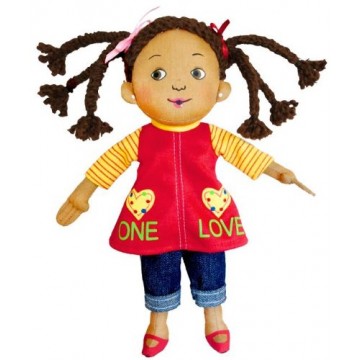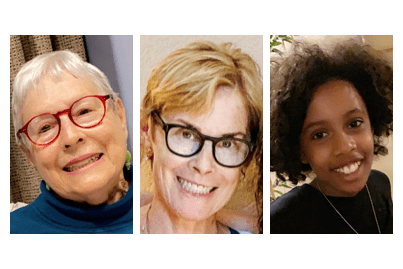My daughter is an Ethiopian born kindergarten-age girl growing up in white America, so when the whole princess thing entered our home, I took an anxious, fearful sigh and—as my grandmother used to say—girded my loins.
The first reckless gift came hidden beneath gold embossed pink paper: a bejeweled tiara with matching earrings, wand, and sparkly plastic high heels. As I gasped in horror, my mind screaming, Oh, God, no, my girl shrieked with delight. Had I known what lurked behind the embellished wrapping, I would have unwrapped it in the closet and, while she stacked wood blocks and played “restaurant” at preschool, taken it to the consignment shop. What she doesn’t know won’t hurt her, right?

In my perfect world, plastic doesn’t exist, and dressing up is saved for Mommy’s closet. Then again, I was born in the 60s, when a mother set seemingly normal limits on what a young girl was exposed to. Back then, apparently in the dark ages, pre-pubescent girls played with Skipper, Barbie’s younger sister. I was proud of my “Twist ‘n Turn” Skipper. And though I did ask why I wasn’t allowed to play with Skipper’s breasted big sister, I accepted my mother’s answer: “Because you aren’t old enough.” It never occurred to me to beg, whine, or cajole. Back then, for better or worse, I knew if an adult said it was so, it was so.
You can imagine the shock when at a local video rental chain when my daughter (barely four at the time), scoped out and grabbed from among the hundreds of options a… Barbie movie?
“Um, what? Barbie has her own movie now? No. I’m sorry, but you can’t rent a Barbie movie. Ever. How ‘bout Dora? She’s an independent, bi-lingual, adventure seeking girl who can teach you to speak Spanish!”
“No! I want Barbie!”
Well, of course she wants Barbie. Wasn’t that Mattel’s mission from the moment Barbie was born? Convince every girl just out of diapers she needs to own a dozen plastic big-breasted, skinny-waisted, longhaired dolls that love fashion and flirting? Though Mattel’s co-founders, Ruth and Elliot Handler, and Harold “Matt” Matson, didn’t intend to create a toy that would become the bane of the Feminist’s existence, Barbie became just that. But Barbie’s story is not just skin deep.
It was 1945 in a garage workshop in Southern California, when the Mattel brand was launched. Just three years later the company incorporated and moved into a Hawthorne, California warehouse. In 1959, inspired by her daughter’s interest in paper dolls, Ruth Handler created the first non-baby doll and named her Barbie, her daughter’s nickname. Her intention was—according to Huffington Post blogger Dr. Susan Albers in her book review of Barbie and Ruth: The Story of the World’s Most Famous Doll and the Woman Who Created Her, by Robin Gerber, to provide girls with a play doll onto which they could project themselves. This doll would allow girls to pretend they were grown-up with grown-up careers and lifestyle.
“So, in some ways,” Dr. Albers writes, “she may have actually helped women to start practicing other roles, besides being a mother, earlier in their life.” With their Barbie dolls, girls could pretend to go to work, travel, or play, not just be mothers, the only role girls could personify when playing with a baby dolls.
Unfortunately, not unlike Dr. Frankenstein’s monster, once she left her creator’s domain, Barbie took on a life of the mass market’s making. By the year 2013, Barbie barely resembles the original, U.S.A.-made doll. Her clothes now reflect a less career-oriented, liberated woman, and more like one of the Real Housewives of Beverly Hills.

I am not the only one who feels frustrated over the lack of toys and media offered to a public whose “Big Brother” encourages girls to gravitate towards all things buxom and plastic. There are a growing number of women (including Caucasian adoptive moms like me who are raising brown-skinned girls in a society that would make their ancestors weep) who are thirsty for media that reflect our real lives, both inner and outer.
I did not, however, set out to write a story about Barbie. But in order to account for my zeal about a newly discovered online resource, A Mighty Girl, a backstory was necessary. For, if such multi-dimensional, girl-empowering, thoroughly-vetted and easily-accessible books, movies, toys, and clothing, like those compiled by A Mighty Girl, were as visible as the mass marketed, unoriginal, perpetually stereotypical crap found in our nation’s Walmarts and Targets then this article would not have germinated in the first place.
Thanks to an assignment from my super cool Managing Editor at InReads, I struck gold and I’m here to share the spoils with you, my global gaggle of awesome and smart, cutting-edge mommies. If you check out my posts at the aforementioned link, you will get the basic lowdown/how-to about the site. For all of you especially inspired Global Moms out there, though, below I’ve provided exact links that you can use at your joyful leisure.
* * *
A Mighty Girl was conceived when one young couple became frustrated with how much time they were spending researching the best books to buy for their four nieces every time a birthday or a holiday necessitated gift giving. These tech-savvy social entrepreneurs realized there was an unfulfilled niche that they just might have the smarts to fill.
And so, in early 2012, A Mighty Girl was born, and she’s been rapidly growing ever since to become the world’s largest collection of girl-empowering books, toys, movies, clothing, and music. What makes A Mighty Girl so trustworthy is that they do not sell anything; the operation stays afloat by receiving a small commission from Amazon.com and Café Press when browsers purchase the item via A Mighty Girl. This really is a labor of love, as evidenced by the workhorse team of volunteers, many of them moms who feel compelled to contribute to the mission of providing an alternative to what currently is marketed to girls.
Below, you will find a bookmark-able list to keep on file that just might end up becoming your most useful gift giving/curriculum building tool ever:
*Multicultural Fiction — can be further sorted by region or ethnicity using the left menu (including multi-racial)
* History, U.S. — for history and historical fiction featuring American girls and women — this section can be further sorted by African-American history, Asian-American history, etc.
* History, World — for history and historical fiction featuring non-U.S. girls and women — this section can be further sorted by world region
* A Mighty Girl Dolls — features a diverse selection of dolls of many races
* Books about Mighty Girls and Adoption
* Fairy tales / Folktales — you can sort these by region
* Discrimination / Prejudice — you can sort by five different types of discrimination, including racial/ethnic, on the left menu
Additionally, A Mighty Girl has created special features, which you can find via the “Best of” button on their menu bar, on the following relevant topics:
* Top Asian Pacific American Mighty Girl Books
* Top Latino / Hispanic American Mighty Girl Books
* Top Mighty Girl Books on Civil Rights History
Powerful, expansive, strong, monumental—these adjectives define the word Mighty. Once you take the time to peruse A Mighty Girl’s offerings, you will understand why the founders used that word to describe not only their astonishingly well done website, but also the end user, that Mighty Girl you call daughter, niece, student, or friend. Though the girl in your life may not yet feel ready to kiss her Barbie goodbye, you can at least know you’ve done your very best to ensure she knows there is much more to the female half of the world’s population than her anatomy.
Via Dina McQueen, author of Finding Aster: Our Ethiopian Adoption Story. This article was originally published at Kindred. Dina’s history in the publishing world includes freelance travel and essay writing for national magazines and newspapers, editor for several magazines and book publishing companies, and a five-year stint as the owner of her own small publishing company. In her early years as a writer, she enjoyed writing fiction, and won several awards for her short stories. Dina received her Masters Degree in Biography/Autobiography from Vermont ‘s Goddard College. She has facilitated numerous writers with the writing of their memoirs. Dina also copywrites for Lux, a division of Unilever, and regularly freelances for www.inReads.com. She lives in multi-cultural Reston, Virginia with her husband, daughter, and cat. She also wrote an article on adoption for GGA. You can read it here.


